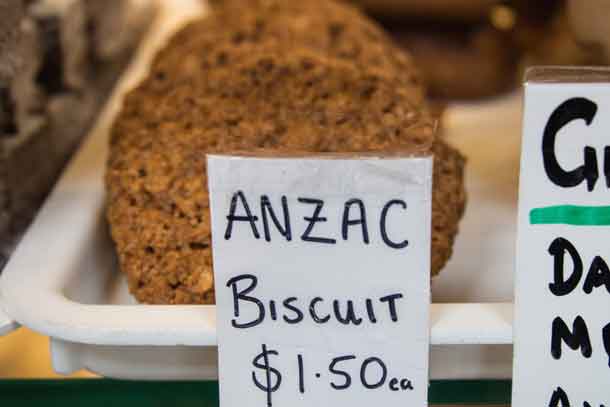
Neat Treat to Try from Australia
By Kathy Hunt – (Zester Daily)
People say travel broadens the mind. In my experience it also expands the palate and occasionally the waistline. Such was the case when visiting Australia and New Zealand and consuming a plethora of sweet, hearty Anzac biscuits.
A favorite of Australians and New Zealanders, Anzac biscuits are about as prevalent and popular as chocolate chip cookies are in the U.S. Geography, though, stops me from calling these oatmeal treats “cookies.” In the United Kingdom and UK territories past and present, small, thin, crisp, flour-based, hand-held baked goods are referred to as “biscuits.”
Taken from the Latin term panis biscotus, which means “bread twice cooked,” biscuits are consumed as snacks. They differ from cookies in that they can be either sweet or savory. However, with Anzac biscuits it’s all about a light, honeyed sweetness and toasty flavor that bring to mind the autumn season.
Anzac biscuits get their name from the World War I troops they nourished.

During the first world war, Australia and New Zealand brought together their countries’ soldiers to form the Australian and New Zealand Army Corps, or ANZAC.
Sent to Egypt for training, the soldiers took along tins of sturdy and wholesome oatmeal biscuits. Loved ones likewise baked and shipped oaty confections thousands of miles to Turkey, where the men were fighting.
Created without eggs, the sweets traveled well and possessed a long shelf life.
These traits came in quite handy, because the baked goods spent two months on a ship without refrigeration before they reached the ANZAC soldiers.
Anzac biscuits at center of celebrations
Had it not been for the ANZAC troops’ fearless efforts and sacrifices at Gallipoli, Turkey, their eponymous treats might have drifted into obscurity. However, as a result of the corps’ bravery during the eight-month campaign starting in 1920, Australia, New Zealand, Tonga, Samoa and the Cook Islands all celebrate ANZAC Day.
Held on April 25, the first day of the Gallipoli campaign, this day of remembrance includes the baking and consuming of Anzac biscuits. Placed in decorative tins, the sweets are also sold to raise funds for military veterans and, during wartime, war efforts.

According to New Zealand’s National Army Museum, a reference to Anzac biscuits first appeared in print there in 1921. The traditional recipe consisted of rolled oats, flour, sugar, butter and golden syrup. The last ingredient, golden syrup, may not sound familiar to American ears, but it’s a common ingredient in British and some Oceanic dishes. Made by refining cane sugar or beet sugar juice, golden syrup — or light treacle as it’s also known — possesses a rich, slightly caramel flavor and smooth, viscous texture similar to honey or corn syrup.
If you can’t track down golden syrup, you can substitute light corn syrup. Because Anzac biscuits require so little golden syrup, I use honey instead of the corn syrup alternative. In this recipe, the difference is negligible.
Another option is to include shredded coconut. Some bakers add it to this simple batter. Others don’t. I find that sweetened shredded coconut brings complexity and a richer flavor to the biscuit. If you’re not a coconut fan, feel free to omit it.
What you shouldn’t change is the low temperature and longer baking time demanded by these sweets. By keeping the oven thermometer at 325 F and baking the Anzacs for roughly twice as long as you would oatmeal or chocolate chip cookies, 20 minutes vs. 8 to 12 minutes, you end up with the crispness and hardiness for which the biscuits are famed.
When stored in an airtight container in a cool, dry place, Anzac biscuits will keep for a minimum of three weeks. Some bakers claim their biscuits remain palatable for up to three months. Although that may seem excessively long, I do know that, when bundled in plastic wrap, sealed in airtight, plastic bags and frozen, they will last for at least three months.
Should you find yourself traveling through Australia or New Zealand, look for Anzac biscuits in supermarkets, restaurants, cafes, bakeries and biscuit shops. They’re a beloved specialty and one not to be missed. Generally, they are served alongside tea or dark coffee. Dunking the cookies into either hot drink is encouraged but not required.
Anzac Biscuits
Prep time: 5 minutes
Bake time: 20 minutes
Total time: 25 minutes
Yield: 3 dozen cookies
Ingredients
1 1/2 cups all-purpose flour
1 1/2 cups rolled oats
3/4 cup firmly packed light brown sugar
3/4 cup sweetened shredded coconut
Pinch salt
10 tablespoons unsalted butter
1 1/2 tablespoons honey
3/4 teaspoon vanilla
1 1/2 tablespoons boiling water
3/4 teaspoon baking soda
Directions
1. Preheat the oven to 325 F. Line two baking sheets with parchment paper.
2. Sift the flour into a large bowl. Add the oats, brown sugar, coconut and salt and toss to combine.
3. In a small saucepan, melt the butter over medium heat. Whisk in the honey and vanilla and remove the pan from the heat.
4. Combine the boiling water and baking soda in a small bowl and stir together. Pour the water mixture into the butter mixture and stir together. Note that combining the two liquids will cause them to foam up.
5. Make a well in the center of the dry ingredients and pour the liquids into this. Stir the wet and dry ingredients together until a well-combined, crumbly batter forms.
6. Using a tablespoon, measure out equal amounts of batter and place each tablespoonful onto the parchment-lined baking sheet. Leave roughly 1 inch between each cookie.
7. Bake for 20 minutes, until the biscuits have browned. Remove them from the oven and cool for 10 minutes before placing them on wire racks to cool completely. Store in airtight containers.
Copyright Kathy Hunt via Zester Daily and Reuters Media Express
